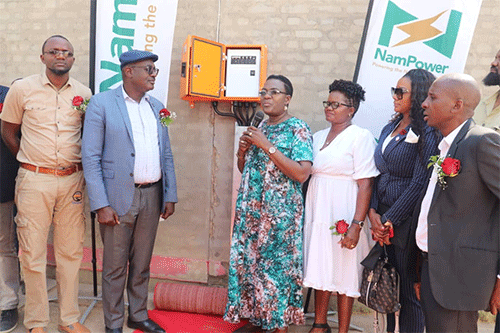Hileni Mwandingi
OMAUNI – Government has said the vast country inhabited by a small population is the reason why only half of Namibian households have electricity but it is committed to tackle the challenge by 2040.
The Deputy Minister of Mines and Energy, Kornelia Shilunga, who was speaking during the official inauguration of the Ohangwena region’s electrification project at Shatipamba Combined School, in Omauni village last Thursday, said electricity is a necessity of life and should be in every village, farm and settlement. However, Namibia’s vast space and low population density has made this ambition challenging and costly, leaving 50% of the households still without modern electricity.
“This is a national challenge that the government, through MME is committed to tackling. To this end, the MME has set a target to have all the households in Namibia electrified by 2040. Achieving this goal will require a collaborative effort from all stakeholders,” said Shilunga, who added her ministry is working hard to establish electrification support mechanisms to accelerate the rate of electrification countrywide and hope to electrify all schools in Namibia by 2025.
“The ministry is cognizant of the many benefits an educated population brings to the nation, therefore, just as the generous share of our national budget is allocated to education, the ministry likewise designs its rural electrification programme around electrifying schools. We have therefore set ourselves a target to electrify all schools in Namibia by 2025,” said Shilunga.
She added that despite not being technically or economically viable, the ministry has designed off-grid solar systems to provide electricity to remote schools and clinics. She thus called on the beneficiaries to make the most of the investments by being efficient and using electricity for productive purposes.
In a speech read on his behalf, NamPower’s Managing Director Kahenge Haulofu said the Ohangwena localities electrification project costs N$17.5 million, which was used in the construction of medium and low voltage networks in different areas of the region.
He added that NamPower is committed to provide electricity to rural communities to improve the living standard of each Namibian and increase economic and commercial activities in their communities.
“NamPower has since its inception, invested millions into the electrification of rural communities and un-electrified public institutions nationwide. We are committed to partnering with the GRN to expand electricity supply infrastructure to rural areas of Namibia in fulfilment of our social responsibility philosophy and our brand promise ‘powering the nation and beyond’,” said Haulofu.
Ohangwena governor Walde Ndevashiya said rural electrification could empower rural enterprises, which can help in poverty eradication and reduction of unemployment.
“There is clear evidence that rural electrification in Namibia, and Ohangwena region, in particular, improves the income and welfare of rural households. Therefore, there is economic justification for investment in rural electrification. By extending electricity to the economically vulnerable, there is a potential for empowering the development of rural enterprises, which can lift people out of poverty,” said Ndevashiya.


